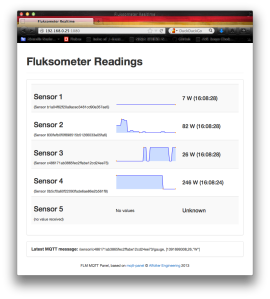I am not a screen designer; when I see certain apps I must admit a “wow” and ask myself how some people get the “feeling” into what they create as a visualization or user interface. Being humble, I orient myself at already well-designed things, like the mqtt panel created by Fabian Affolter available at http://github.com/fabaff/mqtt-panel – nevertheless I try to understand the inner core of such a “thing” and project it onto something else that might also need a fresh-up (*see footnote).
So, the mqtt panel was an inspiration for my own Fluksometer panel that finally works by now. It is able to automatically retrieve up to five sensors configured (update: in the current version “any number” of sensors following the FLM’s sensor topic scheme) and displaying current gauges in a well-arranged outline. Originally written on a Raspberry Pi that could act as a web server also continuously, I just found out that any node.js environment is sufficient to run the FLM mqtt panel. So I am able now to get a peek on my FLM on my iMac. See for yourselves and try it out…
See https://github.com/gebhardm/energyhacks/tree/master/RaspberryPi/panel to get the code.
*I just learned that the process of evolving or also “inventing” something from different results of others is called “Conceptual Blending (https://en.wikipedia.org/wiki/Conceptual_blending)” – at university we called it “help oneself from others” (Steve Jobs named it “stealing”), to use or fit in methods, concepts, algorithms into problem spaces not intentionally seen (I used it for a group symmetry detection algorithm in discrete geometry “borrowed” from algebra).

[…] MQTT gauges for the FLM […]